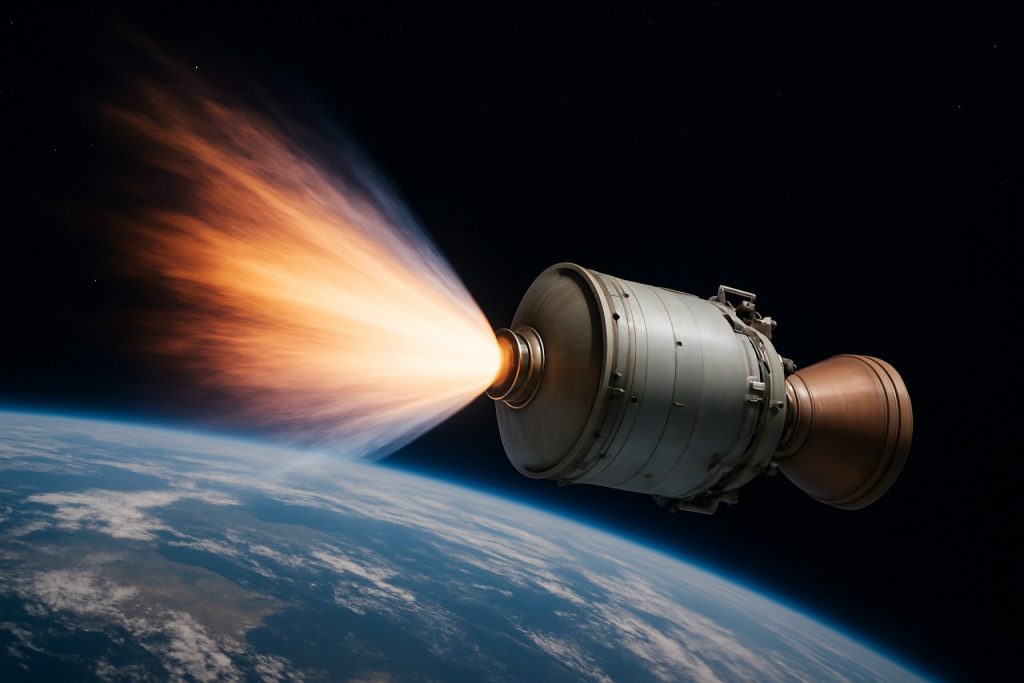
Unlocking New Frontiers: How Apogee Kick Motor Technology is Transforming Satellite Deployment and Space Maneuvering. Discover the Innovations Powering Next-Generation Orbital Insertion.
- Introduction to Apogee Kick Motors: Purpose and Evolution
- Key Principles of Apogee Kick Motor Operation
- Historical Milestones in Apogee Kick Motor Development
- Propellant Choices: Solid vs. Liquid Apogee Motors
- Design Challenges and Engineering Solutions
- Integration with Satellite Platforms and Launch Vehicles
- Performance Metrics and Reliability Considerations
- Recent Innovations and Emerging Technologies
- Case Studies: Successful Missions Utilizing Apogee Kick Motors
- Future Prospects and Trends in Apogee Kick Motor Technology
- Sources & References
Introduction to Apogee Kick Motors: Purpose and Evolution
Apogee Kick Motors (AKMs) are specialized rocket propulsion systems designed to perform critical orbital maneuvers, most notably the transition of a spacecraft from a geostationary transfer orbit (GTO) to its final geostationary orbit (GEO) or other high-energy orbits. The term “apogee” refers to the point in an elliptical orbit farthest from Earth, where the kick motor is typically ignited to maximize the efficiency of the maneuver. The primary purpose of an AKM is to provide the necessary velocity change (delta-v) to circularize the orbit and achieve the desired operational altitude and inclination for satellites, particularly communications and weather satellites.
The evolution of apogee kick motor technology reflects broader advancements in propulsion and satellite deployment strategies. Early AKMs were predominantly solid-propellant motors, valued for their simplicity, reliability, and storability. Notable examples include the Star series developed by Northrop Grumman (formerly Thiokol and Orbital ATK), which have been widely used for decades in both commercial and government missions. Solid-propellant AKMs are typically integrated with the satellite and activated autonomously after separation from the launch vehicle, providing a single, high-thrust burn to achieve the final orbit.
As satellite missions have grown more complex and demanding, liquid-propellant apogee engines have gained prominence. These engines, such as the LEROS series produced by Nammo, offer higher specific impulse and the ability to perform multiple burns, allowing for greater flexibility in mission planning and orbit insertion. Liquid apogee engines are especially advantageous for missions requiring precise orbital adjustments or extended operational lifetimes. The shift toward electric propulsion systems, such as Hall-effect and ion thrusters, represents the latest stage in AKM evolution. While these systems provide much lower thrust, they offer exceptional efficiency and can gradually raise a satellite’s orbit over weeks or months, significantly reducing launch mass and cost.
The development and deployment of apogee kick motors are closely linked to the requirements of satellite operators and the capabilities of launch service providers. Organizations such as European Space Agency (ESA) and NASA have contributed to the advancement of AKM technology through research, testing, and mission integration. Today, the choice of apogee kick motor technology is a critical factor in satellite mission design, balancing considerations of cost, reliability, performance, and mission duration.
Key Principles of Apogee Kick Motor Operation
Apogee Kick Motors (AKMs) are specialized rocket engines designed to perform the critical maneuver of circularizing a satellite’s orbit at its apogee, typically transitioning from a highly elliptical geostationary transfer orbit (GTO) to a circular geostationary Earth orbit (GEO). The key principles of AKM operation are rooted in orbital mechanics, propulsion technology, and precise timing.
The fundamental operational principle of an AKM is the application of the Hohmann transfer, a two-impulse maneuver in which the satellite, after being delivered to GTO by a launch vehicle, uses the AKM to provide the necessary velocity increment (delta-v) at apogee. This burn raises the perigee of the orbit, effectively circularizing it at the desired altitude. The timing and orientation of the burn are critical, as the maneuver must be executed at the precise moment the satellite reaches apogee to maximize efficiency and minimize propellant consumption.
AKMs are typically either solid or liquid propellant engines. Solid-propellant AKMs, such as those developed by Northrop Grumman and ArianeGroup, offer simplicity, reliability, and high thrust-to-weight ratios. They are often chosen for their ease of integration and minimal operational complexity, as ignition is a single-event process. Liquid-propellant AKMs, on the other hand, provide the advantage of restart capability and precise thrust modulation, which can be critical for missions requiring fine orbital adjustments. Organizations like ArianeGroup and Indian Space Research Organisation (ISRO) have developed both solid and liquid AKMs for various satellite missions.
The design of an AKM must account for several key factors: thrust level, specific impulse (a measure of propellant efficiency), mass, and integration with the satellite’s structure and avionics. The motor must deliver sufficient thrust to achieve the required delta-v while minimizing mass to maximize payload capacity. Thermal management, structural integrity under acceleration, and compatibility with satellite deployment mechanisms are also essential considerations.
Guidance, navigation, and control (GNC) systems play a pivotal role in AKM operation. These systems ensure the motor is oriented correctly before ignition and maintain stability during the burn. Modern AKMs are often equipped with onboard sensors and autonomous control algorithms to execute the maneuver with high precision, compensating for any deviations in trajectory or attitude.
In summary, the operation of an Apogee Kick Motor is a complex interplay of propulsion engineering, orbital mechanics, and real-time control, enabling satellites to achieve their final operational orbits with high reliability and efficiency.
Historical Milestones in Apogee Kick Motor Development
The evolution of Apogee Kick Motor (AKM) technology has been pivotal in advancing satellite deployment and orbital maneuvering capabilities. The concept of the AKM emerged in the early days of satellite launches, as engineers recognized the need for a dedicated propulsion stage to circularize or adjust the orbit of payloads after separation from the launch vehicle’s upper stage. This requirement became especially pronounced with the advent of geostationary satellites, which necessitated precise insertion into geosynchronous orbits.
One of the earliest milestones in AKM development was the use of solid-propellant motors in the 1960s and 1970s. These motors, such as the Star series developed by Northrop Grumman (formerly Thiokol and later Orbital ATK), provided reliable and relatively simple solutions for imparting the necessary velocity change (delta-v) at apogee. The Star 24 and Star 48 motors became industry standards, with the Star 48 notably used in missions such as the deployment of the Tracking and Data Relay Satellite System (TDRSS) and various commercial communications satellites.
The 1980s and 1990s saw significant advancements with the introduction of liquid-propellant apogee engines, offering higher specific impulse and improved controllability. The R-4D engine, originally developed for the Apollo program by NASA and later produced by Aerojet Rocketdyne, became a widely adopted solution for geostationary transfer orbit (GTO) to geostationary orbit (GEO) maneuvers. Its reliability and restart capability made it a preferred choice for many commercial and governmental satellite platforms.
A major milestone in the 21st century has been the shift toward electric propulsion for apogee maneuvers. Companies such as Airbus and Thales Group have pioneered the use of Hall-effect and ion thrusters, which, while providing lower thrust, offer significantly higher efficiency and mass savings. This transition has enabled satellite operators to launch heavier payloads or extend mission lifespans, fundamentally changing the economics and design of geostationary satellites.
- 1960s–1970s: Introduction of solid-propellant AKMs (e.g., Star series by Northrop Grumman)
- 1980s–1990s: Adoption of liquid-propellant engines (e.g., R-4D by Aerojet Rocketdyne)
- 2000s–present: Emergence of electric propulsion (e.g., Hall-effect thrusters by Airbus, Thales Group)
These milestones reflect the ongoing innovation in apogee kick motor technology, driven by the demands of increasingly complex and ambitious space missions.
Propellant Choices: Solid vs. Liquid Apogee Motors
Apogee kick motors (AKMs) are critical propulsion systems used to transfer satellites from a geostationary transfer orbit (GTO) to their final geostationary orbit (GEO) or other high-energy orbits. The choice of propellant—solid or liquid—significantly influences the design, performance, and operational flexibility of these motors. Both solid and liquid apogee motors have been widely adopted, each offering distinct advantages and trade-offs.
Solid Apogee Motors (SAMs) are characterized by their simplicity, reliability, and compactness. The propellant is pre-cast into the motor casing, making the system robust and less susceptible to leaks or handling hazards. Once ignited, a solid motor burns to completion, providing a high-thrust, short-duration impulse ideal for rapid orbit raising. This simplicity translates to fewer moving parts and lower risk of mechanical failure, which is why solid apogee motors have been extensively used in commercial and government satellite missions. Notable examples include the STAR series developed by Northrop Grumman and the Apogee Motor Assembly (AMA) used in various spacecraft. However, the inability to throttle, restart, or shut down the motor mid-burn limits mission flexibility and precision in orbit insertion.
Liquid Apogee Motors (LAMs) offer greater control and efficiency compared to their solid counterparts. These engines typically use hypergolic propellants—fuels and oxidizers that ignite on contact—such as monomethylhydrazine (MMH) and nitrogen tetroxide (N2O4). The ability to start, stop, and throttle the engine allows for precise orbit adjustments and multiple burns, which is particularly advantageous for complex mission profiles or when fine-tuning is required for station-keeping. The ArianeGroup and Indian Space Research Organisation (ISRO) are among the organizations that have developed and deployed liquid apogee motors for their satellite platforms. The main drawbacks of LAMs are increased system complexity, the need for pressurization and plumbing, and the handling hazards associated with toxic propellants.
The selection between solid and liquid apogee motors is driven by mission requirements, cost, and risk tolerance. Solid motors are often favored for their reliability and simplicity in missions where precise orbit insertion is less critical. In contrast, liquid motors are chosen for missions demanding high precision and flexibility. Ongoing advancements in both solid and liquid propulsion technologies continue to shape the landscape of apogee kick motor applications, with hybrid and green propellant options also under exploration by leading aerospace organizations.
Design Challenges and Engineering Solutions
Apogee Kick Motors (AKMs) are critical propulsion systems used to circularize the orbits of satellites after their initial deployment into elliptical transfer orbits, particularly for geostationary missions. The design and engineering of AKMs present a unique set of challenges, driven by the need for high reliability, precise thrust control, and efficient mass utilization. Addressing these challenges requires innovative solutions in propulsion chemistry, structural engineering, and system integration.
One of the foremost design challenges is achieving the necessary thrust and specific impulse within the strict mass and volume constraints of satellite payloads. AKMs must deliver a significant velocity increment (delta-v) to transition satellites from Geostationary Transfer Orbit (GTO) to Geostationary Earth Orbit (GEO), often in a single, precisely timed burn. This necessitates the use of high-energy propellants. Solid propellant motors, such as those developed by Northrop Grumman and ArianeGroup, offer simplicity and reliability, but their one-time ignition and lack of throttling can limit mission flexibility. In contrast, liquid apogee engines, like those produced by ArianeGroup and Rocket Lab, provide restart capability and finer thrust control, but introduce complexity in terms of propellant storage, feed systems, and thermal management.
Thermal and structural stresses during ignition and operation pose another significant challenge. The motor casing must withstand high internal pressures and temperature gradients without excessive mass penalty. Advanced composite materials and optimized nozzle designs are employed to balance strength, weight, and thermal resistance. For example, carbon fiber-reinforced casings and ablative or radiatively cooled nozzles are common engineering solutions to these issues.
Precision in thrust vector control is essential for accurate orbit insertion. Many AKMs incorporate gimbaled nozzles or auxiliary thrusters for attitude control during the burn. The integration of these systems must ensure minimal disturbance to the satellite’s orientation and structural integrity. Additionally, the interface between the AKM and the satellite bus must be robust enough to transmit thrust loads while minimizing vibration and shock, which could damage sensitive payloads.
Finally, reliability is paramount, as the failure of an AKM typically results in mission loss. Rigorous ground testing, quality assurance protocols, and redundant design features are standard practices among leading manufacturers such as Northrop Grumman and ArianeGroup. The continual evolution of materials science, propulsion chemistry, and systems engineering underpins ongoing improvements in AKM technology, ensuring these motors meet the demanding requirements of modern space missions.
Integration with Satellite Platforms and Launch Vehicles
Apogee Kick Motor (AKM) technology plays a pivotal role in the deployment of satellites into their designated orbits, particularly for missions requiring transfer from a geostationary transfer orbit (GTO) to a geostationary Earth orbit (GEO) or other high-energy orbits. The integration of AKMs with satellite platforms and launch vehicles is a complex process that demands precise engineering and coordination between satellite manufacturers, launch service providers, and propulsion system developers.
AKMs are typically solid or liquid rocket motors mounted on the satellite bus. Their primary function is to provide the final velocity increment (delta-v) necessary to circularize the satellite’s orbit at apogee after separation from the launch vehicle. This integration process begins during the satellite design phase, where the mass, structural interface, and control systems of the AKM must be harmonized with the satellite’s architecture. The propulsion system must be compatible with the satellite’s power, thermal, and command subsystems, ensuring reliable ignition and operation in the space environment.
From the launch vehicle perspective, the AKM is usually stowed within the payload fairing and attached to the satellite. After the launch vehicle places the satellite-AKM stack into the transfer orbit, the satellite separates and, at the appropriate orbital position, the AKM is ignited. This sequence requires careful coordination to avoid contamination, ensure structural integrity during launch loads, and guarantee safe separation and ignition. Leading launch providers such as ArianeGroup and United Launch Alliance have developed standardized interfaces and procedures to accommodate a variety of AKM-equipped payloads.
Satellite manufacturers, including major players like Airbus and Lockheed Martin, design their platforms to support different types of AKMs, whether solid-propellant motors for simplicity and reliability or liquid-propellant systems for higher performance and controllability. The choice of AKM technology and its integration strategy is influenced by mission requirements, satellite mass, and the capabilities of the selected launch vehicle.
Recent advancements in electric propulsion are also impacting AKM integration. Some modern satellites now use high-efficiency electric thrusters for orbit raising, reducing the need for traditional chemical AKMs. However, for missions requiring rapid orbit insertion or for heavier payloads, conventional AKMs remain essential. The ongoing collaboration between propulsion developers, satellite integrators, and launch service providers ensures that AKM technology continues to evolve, supporting a wide range of mission profiles and satellite platforms.
Performance Metrics and Reliability Considerations
Apogee Kick Motors (AKMs) are critical propulsion systems used primarily to transfer satellites from a geostationary transfer orbit (GTO) to their final geostationary orbit (GEO) or other high-energy orbits. The performance and reliability of AKM technology are paramount, as a failure can result in the loss of a satellite mission. Key performance metrics for AKMs include specific impulse (Isp), thrust, mass efficiency, ignition reliability, and operational flexibility.
Specific Impulse and Thrust
Specific impulse (Isp) is a fundamental measure of rocket engine efficiency, representing the thrust produced per unit of propellant consumed. For AKMs, a higher Isp translates to more efficient use of onboard propellant, allowing for either increased payload mass or extended mission life. Solid-propellant AKMs, such as those developed by Northrop Grumman and Aerojet Rocketdyne, typically achieve Isp values in the range of 280–300 seconds, while liquid bipropellant systems can exceed 320 seconds. Thrust levels are tailored to the satellite mass and mission profile, with typical AKMs delivering between 10 and 50 kN of thrust.
Mass Efficiency and Integration
The mass fraction of the AKM—defined as the ratio of propellant mass to total system mass—directly impacts the payload capacity of the launch vehicle. Modern AKMs are designed for high mass efficiency, utilizing lightweight composite casings and optimized nozzle designs. Integration with the satellite bus is another critical factor, as the AKM must withstand launch loads and operate reliably in the space environment. Companies such as ArianeGroup and Indian Space Research Organisation (ISRO) have developed advanced integration techniques to minimize system mass and maximize reliability.
- Ignition Reliability: AKMs are typically single-use, so ignition reliability is crucial. Redundant ignition systems and extensive ground testing are standard practices to ensure near-perfect reliability.
- Operational Flexibility: Some modern AKMs, especially those using liquid propellants, offer restart capability and variable thrust, providing greater mission flexibility compared to traditional solid motors.
- Thermal and Structural Robustness: AKMs must operate in the harsh thermal and vacuum conditions of space. Robust thermal insulation and structural design are essential to prevent failure during the critical apogee maneuver.
Reliability is further enhanced through rigorous qualification and acceptance testing, including vibration, thermal vacuum, and hot-fire tests. Organizations such as NASA and European Space Agency (ESA) set stringent standards for AKM performance and reliability, ensuring that these systems meet the demanding requirements of modern satellite missions.
Recent Innovations and Emerging Technologies
Apogee Kick Motors (AKMs) are critical propulsion systems used to transfer satellites from a geostationary transfer orbit (GTO) to their final geostationary orbit (GEO) or other mission-specific orbits. Recent years have witnessed significant innovations in AKM technology, driven by the demand for higher efficiency, reduced mass, and improved reliability. These advancements are shaping the future of satellite deployment and orbital maneuvering.
One of the most notable trends is the transition from traditional solid-propellant AKMs to advanced liquid and hybrid propulsion systems. Solid-propellant motors, such as those historically produced by Northrop Grumman and Aerojet Rocketdyne, have long been valued for their simplicity and reliability. However, liquid apogee engines (LAEs) are increasingly favored for their higher specific impulse and the ability to throttle or restart, offering greater mission flexibility. Companies like ArianeGroup and OHB System AG are actively developing and integrating high-performance LAEs for commercial and governmental satellite missions.
Another major innovation is the adoption of electric propulsion for apogee maneuvers. Hall-effect thrusters and ion engines, pioneered by organizations such as NASA and European Space Agency (ESA), are now being used for orbit-raising tasks that were once the exclusive domain of chemical AKMs. Electric propulsion offers a dramatic reduction in propellant mass, enabling either lighter satellites or increased payload capacity. For example, the ESA’s all-electric satellite platforms have demonstrated the viability of using electric propulsion for both apogee raising and station-keeping, significantly reducing launch costs and increasing operational lifespans.
Emerging technologies also include the use of green propellants, such as hydroxylammonium nitrate fuel/oxidizer mixtures, which are less toxic and easier to handle than traditional hydrazine-based fuels. NASA and ESA are both investing in the development and qualification of these environmentally friendly alternatives, aiming to enhance safety and reduce ground processing costs.
Additionally, digital design and advanced manufacturing techniques, including additive manufacturing (3D printing), are enabling rapid prototyping and production of complex AKM components. This not only accelerates development cycles but also allows for the optimization of engine performance and integration with next-generation satellite buses.
Collectively, these innovations are transforming apogee kick motor technology, making satellite launches more efficient, cost-effective, and sustainable, while opening new possibilities for mission design and orbital operations.
Case Studies: Successful Missions Utilizing Apogee Kick Motors
Apogee kick motors (AKMs) have played a pivotal role in the deployment of numerous satellites and interplanetary missions, providing the critical final velocity change required to transition spacecraft from transfer orbits to their intended operational orbits. Several high-profile missions have demonstrated the reliability and versatility of AKM technology, with case studies highlighting both solid and liquid propulsion systems.
One of the most prominent examples is the use of the Star 48 solid rocket motor, developed by Northrop Grumman, which has served as an apogee kick motor for a variety of geostationary satellites and interplanetary probes. The Star 48 was notably used in the deployment of the NASA Magellan spacecraft to Venus in 1989. After launch aboard the Space Shuttle Atlantis and release from the Inertial Upper Stage (IUS), the Star 48 motor provided the necessary delta-v to send Magellan on its interplanetary trajectory, demonstrating the reliability of solid-propellant AKMs in deep space missions.
Another significant case is the deployment of communication satellites into geostationary orbit (GEO). The Indian Space Research Organisation (ISRO) has extensively utilized liquid apogee motors (LAMs) for its INSAT and GSAT series satellites. These LAMs, typically using bipropellant systems, are ignited at the apogee of the geostationary transfer orbit (GTO) to circularize the satellite’s orbit at GEO altitude. The successful use of LAMs in missions such as GSAT-6A and GSAT-29 underscores the importance of precise thrust control and restart capability, which are hallmarks of liquid-fueled AKMs.
The European Space Agency (ESA) has also leveraged AKM technology in its Ariane launch vehicle program. The Ariane 4 and Ariane 5 launchers have frequently deployed satellites into GTO, where onboard apogee kick motors—such as the R-4D engine, originally developed by NASA and later produced by Aerojet Rocketdyne—have been used to achieve final orbit insertion. These missions highlight the international adoption and adaptation of AKM technology across different propulsion architectures.
Collectively, these case studies illustrate the critical role of apogee kick motors in mission success, enabling precise orbital maneuvers for a wide range of spacecraft. The continued evolution of AKM technology, including advancements in both solid and liquid propulsion, remains fundamental to the expanding capabilities of satellite and interplanetary missions.
Future Prospects and Trends in Apogee Kick Motor Technology
The future of Apogee Kick Motor (AKM) technology is shaped by evolving mission requirements, advances in propulsion systems, and the growing demand for cost-effective, reliable satellite deployment. Traditionally, AKMs have been solid or liquid rocket engines used to circularize a satellite’s orbit at geostationary altitude after transfer from a launch vehicle. However, several trends are redefining the landscape of AKM development.
One significant trend is the increasing adoption of electric propulsion systems for apogee maneuvers. Electric propulsion, such as Hall-effect thrusters and ion engines, offers much higher specific impulse compared to conventional chemical AKMs, enabling satellites to carry less propellant for the same mission or increase payload mass. This shift is evident in the growing number of commercial and governmental satellites utilizing electric propulsion for orbit raising, a transition supported by organizations like NASA and European Space Agency (ESA). While electric propulsion extends the time required to reach operational orbit, its efficiency and mass savings are driving widespread adoption, especially for large constellations and high-value geostationary satellites.
Another area of innovation is the development of green propellants and advanced chemical propulsion. Traditional hydrazine-based AKMs are being supplemented or replaced by less toxic alternatives, such as LMP-103S and AF-M315E, which offer improved performance and safety. Agencies like NASA and ESA are actively testing and qualifying these propellants for operational use, aiming to reduce environmental impact and handling risks.
Miniaturization and modularity are also influencing AKM technology. The rise of small satellites and rideshare missions has spurred the development of compact, modular AKMs tailored for CubeSats and microsatellites. These systems are designed for rapid integration and compatibility with a variety of launch vehicles, supporting the trend toward more flexible and responsive space operations.
Looking ahead, the integration of digital control systems and advanced materials is expected to further enhance AKM performance. Digital avionics enable more precise thrust control and health monitoring, while new materials can improve thermal resistance and reduce mass. Additionally, the increasing collaboration between commercial manufacturers and space agencies is accelerating the pace of innovation, as seen in joint projects and technology demonstration missions.
In summary, the future of Apogee Kick Motor technology is characterized by a shift toward electric propulsion, adoption of green propellants, miniaturization, and digitalization. These trends are driven by the need for greater efficiency, safety, and adaptability in satellite deployment, with ongoing research and development led by major organizations such as NASA and ESA.
Sources & References
- Northrop Grumman
- Nammo
- European Space Agency (ESA)
- NASA
- ArianeGroup
- Indian Space Research Organisation (ISRO)
- Airbus
- Thales Group
- Rocket Lab
- United Launch Alliance
- Lockheed Martin
- OHB System AG



